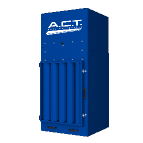 Static pressure is often thought to be a scientific phrase that is irrelevant to operations such as dust collection. In reality, it can be one of the main determining factors in how well a dust collection system performs.
Static pressure is often thought to be a scientific phrase that is irrelevant to operations such as dust collection. In reality, it can be one of the main determining factors in how well a dust collection system performs.
While static pressure is used in many operations, including the design of airplanes and helicopters, it’s most often used when designing HVAC systems. The overall design of dust collection systems is similar to the design of HVAC systems but at much higher pressures.
Static Pressure Explained
Technically speaking, static pressure is defined as the pressure of a fluid on a body when the body is at rest relative to the fluid. A simpler way to think of it is the resistance that air encounters when traveling. Resistance is created by a dust collection system and its associated ductwork.
How Static Pressure Relates to Dust Collection
What is static pressure in a dust collector? Knowing that static pressure is resistance that air movement encounters, you may be wondering how this relates to dust collection. In terms of dust collection, static pressure is air pressure, or resistance, in a dust collector fume hood or duct, expressed in inches of water.
There are a variety of things that cause dust collector static pressure. Something as small as an elbow in a duct to something as in-depth as the passing of air through a tube sheet can cause static pressure in a dust collector. Whether the filters are clean or dirty, they impact static pressure, but the dirty filters have more resistance. When air enters the duct system, it will also cause static pressure. It’s important to be aware of static pressure in a dust collector and reduce friction when you plan your system.
How Static Pressure Is Measured
In the dust collector world, static pressure is generally measured in inches of water in a water gauge. That’s one of the reasons why dust collectors have Magnehelic gauges (differential pressure gauges). These gauges help measure the dust collector static pressure and filter resistance, air velocity and other factors. This determines if the dust collection system is running efficiently or if the system needs maintenance.
When purchasing a fan or a blower, it will be rated for a certain amount of cubic feet per minute (CFM) at a given amount of static pressure. For example, the fan may be rated for 10,000 CFM at 11” of static pressure.
The blower or fan on a dust collector directly relates to how efficient that dust collector is. The size or CFM rating of the blower helps to determine the air-to-cloth ratio that the dust collection system is running. If the size of the blower is proportional to the amount of filter media area, the dust collection filters will last longer and the blower will operate at a sustainable rate. Thus, the dust collector will be more efficient.
Choosing the Right Dust Collector
It’s important to know the total amount of dust collector static pressure so that we can choose the right fan to supply the right amount of CFM. If the fan supplied with a dust collector can’t handle the static pressure, it will not perform properly and the dust collector will not do its job.
Choosing the right industrial dust collector is an important long-term decision. Not only do dust collectors clear the air, but they also improve employee efficiency, increase employee retention, help ensure a safe working environment and reduce equipment maintenance costs. This means that keeping your facility clean can be good for your bottom line.
Dust collector price is often top of mind when selecting a dust collector, but there is so much more to the selection process. There are many things you should consider when it comes time to buy an industrial dust collector in order to select a system that works effectively to clear the air.
For further information on dust collector static pressure, or to find the right dust collection system for your application, discuss your needs with an expert today.



























%20Collectors%20Image.png?width=143&height=143&name=ADC%20(Ambient)%20Collectors%20Image.png)




























.png?width=240&height=91&name=ACT%20Dust%20Collectors%20Logo%20Solid%20White%202020%20(1).png)
.png?width=148&height=149&name=usa-manufactured-dust-collectors%20(1).png)